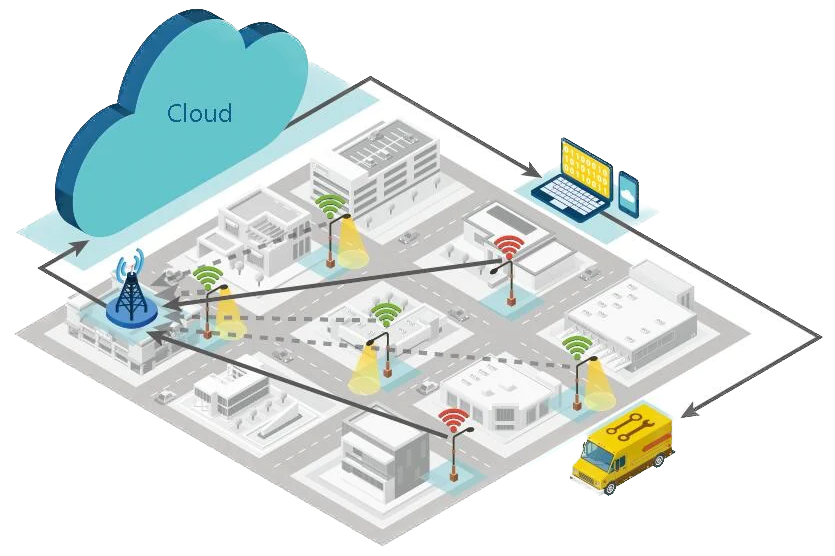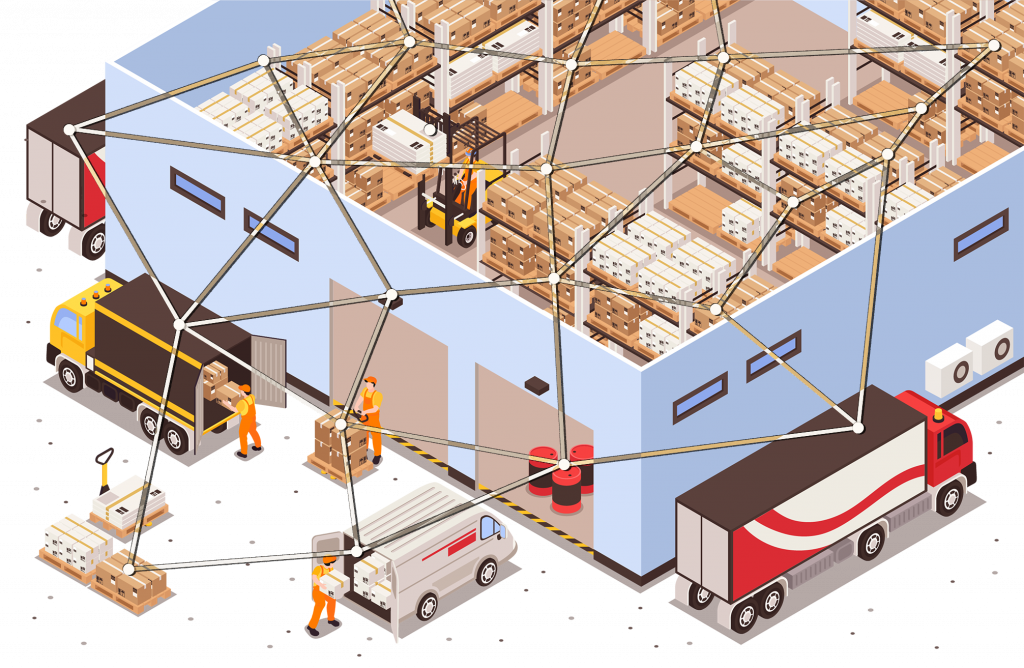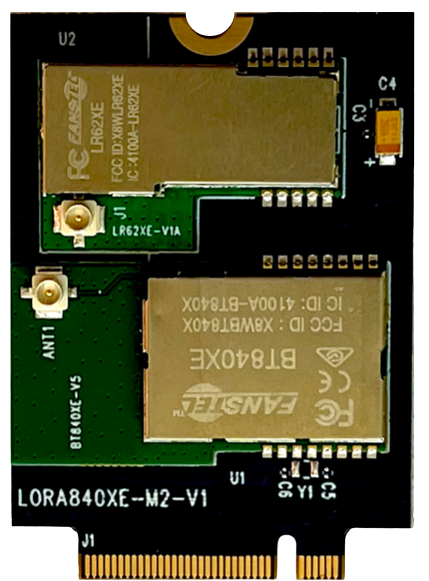
Hybrid Connectivity: LoRaWAN plus Wirepas
This blog focuses on complementary connectivities (LoRaWAN & Wirepas wireless mesh) to better cater for some of the massive IoT applications requiring long-life battery-powered IoT devices that send small amounts of data. Even in that market segment, no single IoT connectivity technology has ubiquitous coverage and is capable of addressing all vertical IoT use cases. We review today how LoRaWAN (one of the leaders and standard in the LPWAN market) and Wirepas (the de-facto industrial wireless mesh technology in 2.4Ghz and 5G 1.9Ghz, also called DECT-2020 NR) can provide optimised solutions by combining their strengths.
LoRaWAN's Strengths
– Popular low power wide area network that has become a kind of standard.
– Low power consumption of devices.
– Long coverage range (up to 10+km in outdoor environments).
– Public or private simple star network architecture.

Here above,
an example of a LoRa Network for street lighting.
LoRaWAN's Limitations
– LoRa protocol is super low bandwidth, up to a maximum of 27 Kbps.
– Latency can be long and unpredictable. LoRaWAN size is limited, based on a parameter called “duty cycle” which varies by countries’ regulations. (not an ideal candidate to be used for real-time applications).
– Network planning is difficult if you have any KPIs to maintain and need redundancy.
– OTAU (over-the-air upgrade) is not really an option, even though it is considered do-able with a small number of devices in your network.
– If a LoRaWAN deployment is successful, then as the number of devices (>10,000s) increases, the risk of lost messages increases as well. There are some solutions, yet more complexities to manage it.
Overcoming LoRaWAN's Limitations
Here comes a good option: Combining the best of both worlds in one device: LoRaWAN + Wirepas (industrial wireless mesh) for use cases where redundancy, OTAU, covering black spots, and/or accurate RTLS (real-time location services) are all important.
To innovate with some kind of mesh technology, some solution providers have developed LoRa P2P (peer-to-peer devices in a LoRaWAN) or also called LoRa D2D (device-to-device).
e.g. Milesight D2D communication -with their own end nodes- is an interesting solution (see video), complementing a LoRaWAN but not really a true wireless mesh, limited in terms of the number of devices, no capabilities to do accurate indoor tracking and very proprietary.
Wirepas wireless mesh technology remains the most secure, reliable, scalable and inter-operable (between vendors) option but does not have the LoRa strength in terms of long range.

Here above,
an example of Wirepas mesh network in a logistics hub.
Applications for Hybrid connectivity
Street Lighting: when some lights might be isolated you want to connect to a LoRaWAN over a long distance, but if you have a lot of lights in the vicinity, you might prefer meshing them over Wirepas to reduce Latency. Having both protocols on the lights, the installer can select to activate LoRaWAN or Wirepas or both (for redundancy) depending on the location of the lights.
Smart Building (black spots): While LoRaWAN is getting some traction in smart building applications, it best works outdoors for monitoring parking spots, weather conditions and meters. If used indoors, there is a requirement to install many gateways to cover for black spots. That’s where Wirepas makes more sense, especially for new buildings where you can set up the mesh network via lights, such as Ingy.nl and apply many IoT applications without black spots or latency, while better controlling all your lights.
Asset tracking: Having a combination of LoRa & Wirepas makes a lot of sense for indoor/outdoor tracking. When assets are outdoors, you can use LoRaWAN + GPS. When indoors, you can still use LoRaWan + wifi sniffing triangulation but Wirepas is way more accurate (up to 3m) and can provide RTLS (real time location services).
Smart metering: EDMI uses Fanstel hybrid boards with their electricity smart meters for redundancy, removing black spots and OTAU. Still relatively new and confidential.
Embedding Both Technologies
There is a new board from Fanstel that embeds both technologies (noting that the Wirepas firmware is embedded on BLE nordic semi NRF52 series).
How does it work?
– The Fanstel V-bus board embeds 2 modules: 1 with a Nordic Semi NRF52 Soc that can be configured as BLE or Wirepas and a Semtech LR62 module for LoRa.
– The board can be configured to switch from BLE to LoRa (& vice versa) or have both active at the same time (but more power-hungry).
– The board includes an integrated antenna for the BLE/Wirepas and a u.FL connector for the LoRa antenna.
Why is it interesting?
– It reduces the cost of implementing such dual technologies into a device.
– It reduces the cost of deployment and TCO (Total Cost of Ownership).
– It provides connectivity redundancy, which more and more customers in large scale projects are looking for to protect their investments.
– It creates new opportunities for the LoRa ecosystem to tackle new customers and new case studies or simply provide an improved solution to current customers.
If such solutions (combining LoRaWAN and Wirepas in a single device) are of interest and you would like to know more about how this could serve your use cases, then Symbiotech would be the right partner. We can also develop the best firmware to optimise battery consumption and mesh parameters of your IoT devices as well as the appropriate commissioning App to handle a large number of devices.
Want to scale up your IoT solution?
Get in touch today to set up a preliminary discussion with our IoT wireless mesh experts to improve your position for the future.
